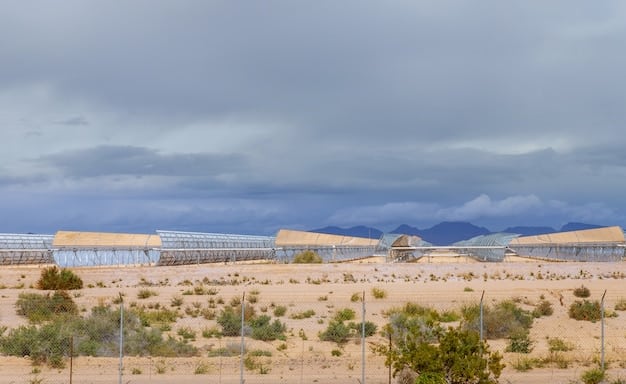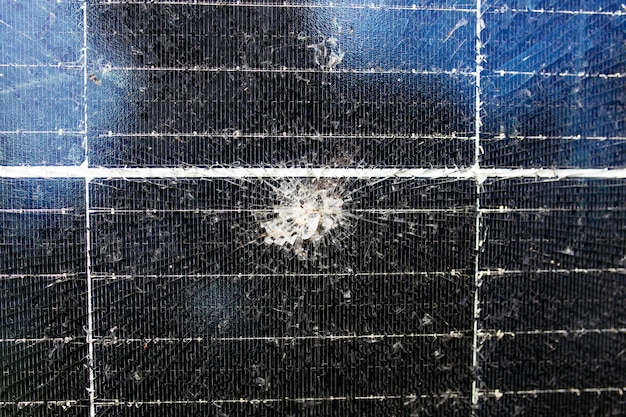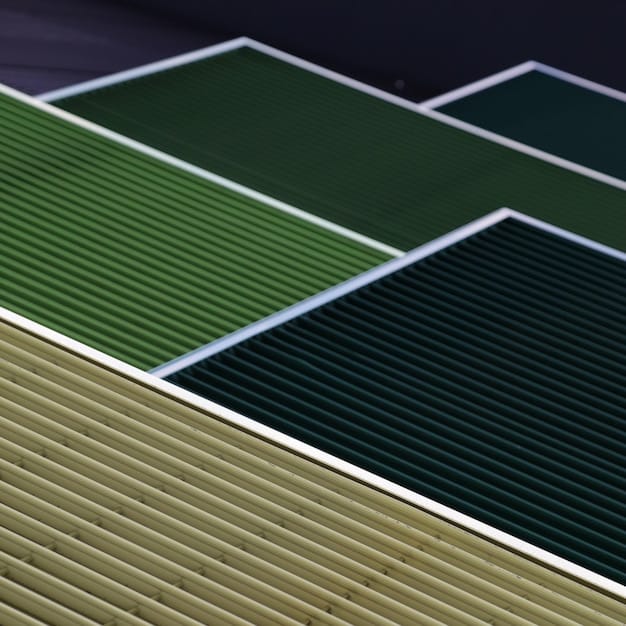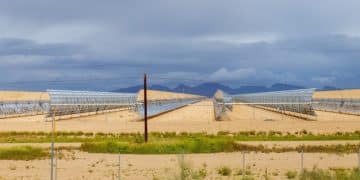Analyzing Thin-Film Solar Cell Performance in Real US Conditions

Analyzing the performance of new thin-film solar cells in real-world US conditions involves evaluating their energy conversion efficiency, stability, and durability under diverse climates and environmental factors to determine their viability for widespread adoption.
Are thin-film solar cells living up to their potential in the diverse climates of the United States? This article delves into analyzing the performance of new thin-film solar cells in real-world US conditions, uncovering their strengths, weaknesses, and future prospects.
Understanding Thin-Film Solar Cell Technology
Thin-film solar cells represent a significant advancement in photovoltaic technology. Unlike traditional silicon-based solar panels, thin-film cells are created by depositing thin layers of semiconductor material onto a substrate, offering flexibility and potentially lower manufacturing costs.
The appeal of thin-film technology lies in its versatility. These cells can be manufactured on a variety of substrates, including glass, plastic, and stainless steel, making them suitable for diverse applications. Furthermore, certain thin-film technologies have the potential to outperform traditional silicon cells in specific conditions.
Key Types of Thin-Film Solar Cells
Several types of thin-film solar cells are currently in use or under development. Each type utilizes different semiconductor materials and offers unique performance characteristics.
- Cadmium Telluride (CdTe): Known for its high efficiency and relatively low cost, CdTe is one of the most commercially successful thin-film technologies.
- Copper Indium Gallium Selenide (CIGS): CIGS cells offer excellent efficiency and stability, making them a promising alternative to CdTe.
- Amorphous Silicon (a-Si): While less efficient than CdTe and CIGS, a-Si cells are inexpensive to manufacture and can be used in flexible applications.
- Organic Photovoltaics (OPV): OPV cells are made from organic materials, offering the potential for very low-cost and flexible solar cells, though their efficiency and lifespan are still under development.
The choice of thin-film technology depends on various factors, including cost, efficiency requirements, and the intended application. Each type presents its own set of advantages and disadvantages, influencing its suitability for specific real-world conditions.
In conclusion, understanding the different types of thin-film solar cells is crucial for evaluating their performance in diverse environments. The unique characteristics of each technology dictate its suitability for specific applications and locations, driving innovation in the field of solar energy.
Challenges of Real-World US Conditions on Solar Cells
The United States presents a diverse range of climatic and environmental conditions that can significantly impact the performance of solar cells. From the scorching deserts of the Southwest to the humid coastal regions of the Southeast, each environment poses unique challenges.
These challenges extend beyond simple sunlight availability. Temperature, humidity, wind, and airborne particles all play a role in the long-term performance and reliability of solar installations.

Impact of Temperature and Humidity
Temperature and humidity are two of the most significant factors affecting solar cell performance. High temperatures can reduce the efficiency of solar cells, while humidity can accelerate corrosion and degradation of components.
- High Temperature Effects: As temperature increases, the band gap of the semiconductor material in the solar cell decreases, leading to a reduction in voltage and overall efficiency.
- Humidity and Corrosion: High humidity can cause moisture to penetrate the protective layers of the solar cell, leading to corrosion of metal contacts and degradation of the semiconductor material.
- Thermal Cycling: Repeated temperature fluctuations can cause stress on the solar cell materials, leading to cracking and delamination.
Mitigating these effects requires careful material selection, robust encapsulation techniques, and effective thermal management strategies. Understanding the specific temperature and humidity profiles of a region is crucial for designing and deploying durable solar installations.
Ultimately, the ability of thin-film solar cells to withstand the challenges of real-world US conditions hinges on innovative engineering and rigorous testing. By addressing the impacts of temperature, humidity, and other environmental factors, we can unlock the full potential of this promising renewable energy technology.
Performance Metrics for Thin-Film Solar Cell Evaluation
Evaluating the performance of thin-film solar cells requires a comprehensive set of metrics that go beyond simple efficiency ratings. These metrics provide insights into the long-term viability, reliability, and economic feasibility of solar installations.
Key performance indicators include energy yield, performance ratio, degradation rate, and lifecycle cost. Each metric offers a unique perspective on the overall performance and value of thin-film solar technology.
Essential Performance Indicators
Understanding these metrics is critical for comparing different thin-film technologies and assessing their suitability for specific applications and locations.
- Energy Yield: Measures the actual energy produced by a solar cell or module over a specific period, taking into account real-world conditions such as temperature, shading, and irradiance.
- Performance Ratio (PR): Compares the actual energy output of a solar system to its theoretical output under ideal conditions, providing a measure of overall system efficiency.
- Degradation Rate: Quantifies the rate at which the performance of a solar cell or module declines over time, indicating its long-term stability and durability.
- Lifecycle Cost: Calculates the total cost of a solar installation over its entire lifespan, including initial investment, maintenance, and replacement costs, providing a measure of economic viability.
By carefully monitoring and analyzing these performance metrics, we can gain a deeper understanding of the strengths and weaknesses of thin-film solar cells. This knowledge is essential for optimizing system design, improving manufacturing processes, and ensuring the long-term success of solar energy deployments.
In essence, a holistic approach to performance evaluation is crucial for driving innovation and increasing the adoption of thin-film solar technology. By focusing on real-world performance and long-term reliability, we can unlock the full potential of solar energy to power a sustainable future.

Case Studies: Thin-Film Solar Cell Performance in the US
Examining real-world case studies provides valuable insights into the performance of thin-film solar cells under diverse US conditions. These studies reveal the strengths and weaknesses of different technologies and highlight the importance of site-specific considerations.
By analyzing data from actual solar installations, we can gain a more accurate understanding of energy yield, performance ratio, and degradation rates. This information is essential for optimizing system design and improving long-term performance.
Examples of Thin-Film Solar Cell Deployments
Several case studies demonstrate the potential and challenges of thin-film solar cells in different regions of the United States.
- Desert Southwest: CdTe solar cells have shown excellent performance in the high-temperature, high-irradiance conditions of the desert Southwest, demonstrating their ability to withstand extreme heat and sunlight.
- Pacific Northwest: CIGS solar cells have proven to be well-suited for the cloudy and rainy conditions of the Pacific Northwest, maintaining reasonable energy yield despite lower levels of sunlight.
- Northeastern US: Amorphous silicon solar cells have been successfully integrated into building-integrated photovoltaics (BIPV) in the Northeastern US, providing a flexible and cost-effective solution for urban environments.
These case studies underscore the importance of matching the right thin-film technology to the specific environmental conditions of a location. By considering factors such as temperature, humidity, and irradiance, we can maximize energy yield and ensure long-term reliability.
In conclusion, case studies provide invaluable real-world data that informs the development and deployment of thin-film solar cells. By analyzing the performance of actual solar installations, we can continuously improve system design and optimize performance for diverse US conditions.
Enhancing Durability and Longevity of Thin-Film Cells
To ensure the widespread adoption of thin-film solar cells, it is crucial to enhance their durability and longevity. Research and development efforts are focusing on improving material selection, encapsulation techniques, and protective coatings.
These advancements aim to mitigate the effects of environmental factors such as temperature, humidity, and UV radiation, extending the lifespan and improving the performance of thin-film solar cells.
Strategies for Improving Durability
Several strategies are being employed to enhance the durability and longevity of thin-film solar cells. These strategies focus on protecting the active materials from environmental degradation and improving the overall robustness of the solar cell module.
- Advanced Encapsulation: Using advanced encapsulation materials and techniques to prevent moisture from penetrating the solar cell module.
- Protective Coatings: Applying protective coatings to the surface of the solar cell to shield it from UV radiation and other environmental stressors.
- Improved Material Selection: Selecting materials that are more resistant to temperature fluctuations, corrosion, and other forms of degradation.
By implementing these strategies, manufacturers can significantly extend the lifespan of thin-film solar cells and improve their performance in harsh environments. Ongoing research and development efforts are continuously yielding new and innovative solutions for enhancing durability and longevity.
In summary, enhancing the durability and longevity of thin-film solar cells is essential for making them a competitive and reliable source of renewable energy. By focusing on material science, engineering design, and manufacturing processes, we can unlock the full potential of this promising technology.
Future Trends in Thin-Film Solar Cell Technology
The future of thin-film solar cell technology is bright, with ongoing research and development efforts pushing the boundaries of efficiency, durability, and cost-effectiveness. Several emerging trends promise to revolutionize the solar energy industry.
These trends include the development of new materials, advanced manufacturing techniques, and innovative applications for thin-film solar cells.
Emerging Trends and Innovations
Several key trends are shaping the future of thin-film solar cell technology. These trends promise to drive down costs, improve performance, and expand the range of applications for solar energy.
- Perovskite Solar Cells: Perovskite solar cells are a rapidly emerging technology that offers the potential for very high efficiency and low manufacturing costs. While still in the early stages of development, perovskite cells have shown remarkable progress in recent years.
- Flexible Solar Cells: Flexible thin-film solar cells are opening up new possibilities for integrating solar energy into unconventional surfaces and devices. These cells can be easilyConclusão
In conclusion, analyzing the performance of new thin-film solar cells in real-world US conditions is crucial for driving innovation and expanding access to clean, renewable energy. By understanding the strengths and weaknesses of different technologies, we can optimize system design and ensure the long-term success of solar deployments across the United States.
Key Point Brief Description ☀️ Efficiency in US Climates Evaluates how thin-film solar panels perform under varying US weather conditions. 💰 Cost vs. Performance Balances the cost and energy production of thin-film cells for practical use. ⚙️ Technology Types Highlights the advantages and applications of different thin-film materials. 🌱 Environmental Impact Addresses the environmental benefits and concerns of thin-film solar tech. FAQ
How efficient are thin-film solar cells in comparison to traditional silicon panels?
▼Thin-film solar cells generally have lower efficiency rates than traditional silicon panels. However, they can perform better in low-light conditions and are more cost-effective to manufacture, balancing the lower efficiency with reduced expenses.
What are the primary advantages of using thin-film solar cells?
▼Key advantages include lower production costs, flexibility in application (such as on curved surfaces), and better performance under high-temperature conditions. Additionally, they require less material, reducing the environmental impact of manufacturing.
How do different US climates affect the performance of thin-film solar panels?
▼Climates with high temperatures and intense sunlight, like the Southwest, can reduce efficiency, but some thin-film types handle heat better. Humid environments may cause corrosion, while flexible panels are applicable to a variety of building styles.
Are thin-film solar cells environmentally friendly?
▼Yes, thin-film solar cells are generally environmentally friendly. They require less energy and material to produce compared to silicon panels. However, some types (e.g., CdTe) require careful recycling due to hazardous materials.
What is the typical lifespan and degradation rate of thin-film solar cells?
▼Lifespan typically ranges from 20 to 30 years, with degradation rates varying by type. CIGS cells, for instance, degrade at about 0.5% per year, while others may degrade faster. Proper encapsulation extends their operational life.
Conclusion
In conclusion, analyzing the performance of new thin-film solar cells in real-world US conditions is crucial for driving innovation and expanding access to clean, renewable energy. By understanding the strengths and weaknesses of different technologies, we can optimize system design and ensure the long-term success of solar deployments across the United States.





